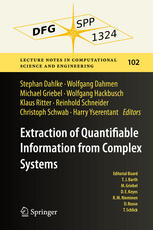

Most ebook files are in PDF format, so you can easily read them using various software such as Foxit Reader or directly on the Google Chrome browser.
Some ebook files are released by publishers in other formats such as .awz, .mobi, .epub, .fb2, etc. You may need to install specific software to read these formats on mobile/PC, such as Calibre.
Please read the tutorial at this link: https://ebookbell.com/faq
We offer FREE conversion to the popular formats you request; however, this may take some time. Therefore, right after payment, please email us, and we will try to provide the service as quickly as possible.
For some exceptional file formats or broken links (if any), please refrain from opening any disputes. Instead, email us first, and we will try to assist within a maximum of 6 hours.
EbookBell Team

5.0
30 reviewsIn April 2007, the Deutsche Forschungsgemeinschaft (DFG) approved the Priority Program 1324 “Mathematical Methods for Extracting Quantifiable Information from Complex Systems.” This volume presents a comprehensive overview of the most important results obtained over the course of the program. Mathematical models of complex systems provide the foundation for further technological developments in science, engineering and computational finance. Motivated by the trend toward steadily increasing computer power, ever more realistic models have been developed in recent years. These models have also become increasingly complex, and their numerical treatment poses serious challenges. Recent developments in mathematics suggest that, in the long run, much more powerful numerical solution strategies could be derived if the interconnections between the different fields of research were systematically exploited at a conceptual level. Accordingly, a deeper understanding of the mathematical foundations as well as the development of new and efficient numerical algorithms were among the main goals of this Priority Program. The treatment of high-dimensional systems is clearly one of the most challenging tasks in applied mathematics today. Since the problem of high-dimensionality appears in many fields of application, the above-mentioned synergy and cross-fertilization effects were expected to make a great impact. To be truly successful, the following issues had to be kept in mind: theoretical research and practical applications had to be developed hand in hand; moreover, it has proven necessary to combine different fields of mathematics, such as numerical analysis and computational stochastics. To keep the whole program sufficiently focused, we concentrated on specific but related fields of application that share common characteristics and as such, they allowed us to use closely related approaches.